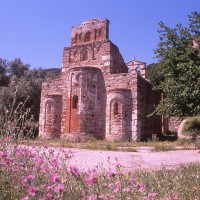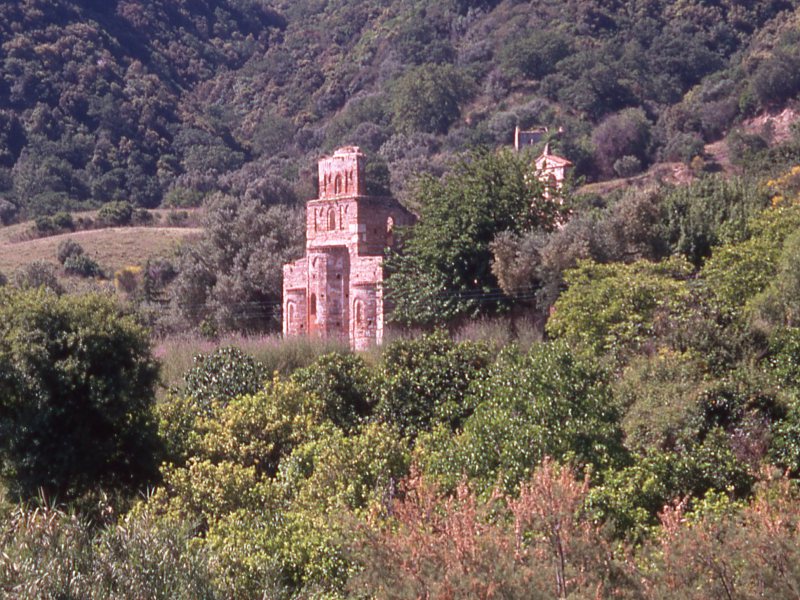Church of Santa Maria de' Tridetti
Descrizione

The Church of Santa Maria de’ Tridetti is situated a few kilometres from Staiti, in a green valley against a protective backdrop of mountains. Today it presents itself as a valuable treasure that time has worn away. The old church probably belonged to a monastery that no longer exists. Part of the nave, as well as sections of the side walls and dome, have been lost forever. Still standing are the body of the presbytery, a small portion of the dome, and the façade of the entrance.
The date of its foundation remains controversial. Some scholars hold that it was built in the second half of the eleventh century (Orsi, Bottari) while others claim that it was built during the first half of the twelfth century (Bozzoni, Schwarz). One fact, however, is certain and that is, that it belongs to the period of the Norman occupation of Calabria (completed in 1060 when Reggio fell), although strong influences of the Byzantine tradition continued to prevail in Calabrian culture and arts for years after the conquest.
The floor plan is basilican, with three naves and a three-part presbytery, the sections of which, according to Eastern liturgical requirements, acted as bema, prothesis and diaconicon. Above the rectangular bema, rose an Islamic-style dome, now ruined. The prothesis and diaconicon, also rectangular, are, however, surmounted by ribbed vaults. On the eastern façade stand three apses protruding outwards, richly decorated in shingles and bricks and containing niches in saw-tooth and dove-tail patterned brickwork.
The church of Santa Maria de’ Tridetti represents a mature blending of eastern and western styles and the creation of one of the first examples of the three-aisled basilica with a non-protruding, triple-apse transept which, in the twelfth century, was to become widespread in Greek-Calabrian and Sicilian architecture.
The same floor plan is to be found, in Calabria, in the church of S. Maria di Terreti (demolished in 1915) and in that of S. Maria del Patir at Rossano. In Sicily one recalls the churches of SS. Pietro e Paolo [Saints Peter and Paul] in Agrò and S. Pietro [St. Peter] in Itàla.
Of clear Islamic inspiration is the general use in this church of pointed arches, present in the aisles and repeated, on a larger scale, on the main façade, between the nave and chancel, and in the space connecting the bema and central apse.
Unusual is the use of the false columns in terracotta discs and wedged into the two edges of the arch of the central apse. These pseudo-columns are topped with upturned reclaimed Ionic capitals that Venditti attributes to the Byzantine taste. The other half columns of the pillars of the nave are, however, surmounted by parallelepiped slabs in fluted stone.
Of particular interest is the form of the cupola, the remains of which still allow us to attribute its geometric and spatial shape to the Islamic tradition. The similarity between this dome and that of the nearby churches of St Giovanni Vecchio at Bivongi and St Anna in Palizzi, is evident. All of them represent the presence in Calabria of a typically Islamic feature found in some of Sicily’s religious architecture: the domed qubba with angular niches that facilitate the passage from the square base to the circular hemispherical dome.
Santa Maria de’ Tridetti, intended for the Greek rite, is a clear testimony to the blending of styles and cultures which, after the fall of the Byzantines, found in these and other churches elsewhere in Calabria and Sicily, eloquent poof of the will to amalgamate. Islamic-style pointed arches, domes with geometric shapes of Fatimid derivation, basilican floor-plans combining the Latin influence and the demands of the Greek rite, typically Byzantine chromatic patterns in cobblestone and brick, make this monument a felicitous testimony to cultural integration that expressed itself architecturally in a manner found nowhere else in the Mediterranean area.












